Where to start?
We are big believers that starting small now is better than starting big, later. We have found that this approach actually makes things happen, helps reduce overwhelm and keeps the budget check. When we first started with solar, our setup was simple.
Our first solar setup is outlined below. This solution gave us the ability to use all the 12v systems in the RV for as long as our fresh and grey water tanks would allow. We could charge laptops, phones and drones as much as needed and never had any issues with the tongue jack, awning or any other onboard 12v systems.
- We had two (2) six-volt Centennial Batteries.
- 120 Watt Zamp Solar Portable Solar panel
- The 600-watt inverter
Now that we’ve started… it’s time to improve
After we purchased “Grand Ginger”, our Grand Design Reflection Bunkhouse (312BHTS), we were ready for more freedom and less fatigue. We were also preparing for more dry-camping during Season 5 in Alaska.
We wanted to create “Tricia-approved dry camping”. This means that Tricia wasn’t looking for the exit button on day 2 because everything was harder. We both wanted to turn the coffee maker on in the morning start working with 100% charged laptops. We wanted to take a warm shower and didn’t want to feel like we were camping. To be clear, there is nothing wrong with camping…but we’re not going home afterward. We wanted to live the same way whether we were in an RV park, Walmart or the most beautiful BLM site in North America.
It was time to get a bigger inverter, but with a bigger inverter comes more batteries and more solar to replenish those batteries.
Below is our Lithium Solar setup with Zamp Solar, Battle Born Batteries and Victron.
The complete freedom solar setup
Here is a diagram of how everything fits together. Jared made this diagram and explains it step-by-step in the video below.
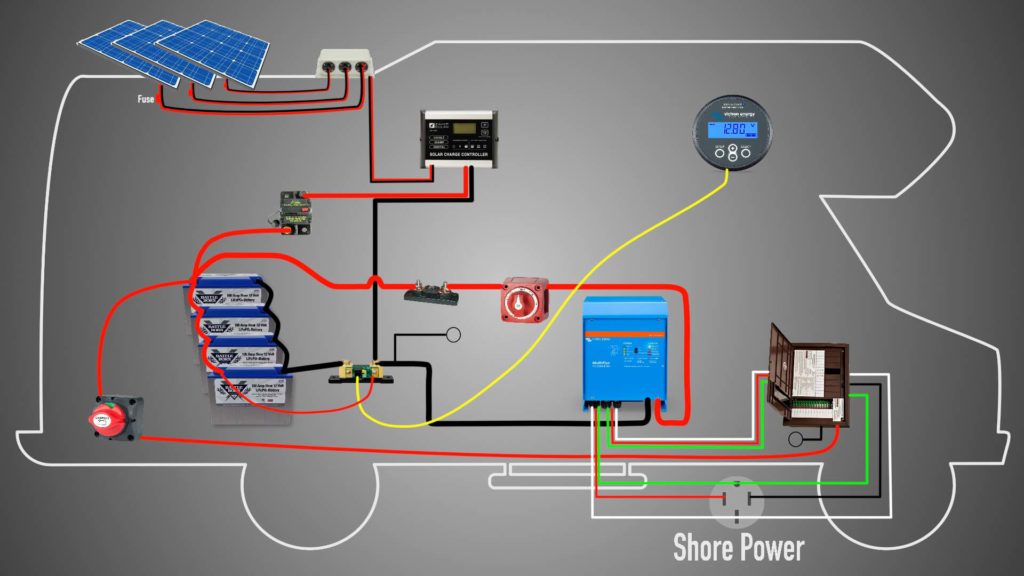
This setup gives us the freedom to stay wherever we want as long as we want. We’re already saving money by not being tethered to RV parks, but as we discussed in the video, we discovered that the biggest benefit was reducing some of the fatigue from day to day travel.
Yeah, this is a lot so why would you do it? First of all, I think it’s safe to assume that you like your rig and you plan on having for a while. If you’re already taking long trips (not necessarily fulltime, but RVing a few months per year) and don’t like RV parks, you’ll make your money back in 48 nights per year over 3 years (not considering the cost of a generator, upkeep, and fuel).
On the other hand, you might not spend that much time away from RV parks, but not everyone in the family “loves to go RVing”! This setup will be able to turn everything ON no matter where you are. We bailed on many amazing BLM (Bureau of Land Management) sites because we just didn’t want the hassle.
Battle Born Lithium Batteries
We’ve been hearing about the benefits of lithium from the start, but we were not experienced enough to understand. In other words, it didn’t translate. As it turns out, we’re really good at destroying batteries. As I mentioned in the video above, each time a lead acid battery goes below 50% it gets a little damaged and each time it goes to zero it losses one more heart (yeah, like a video game). When we’re dry camping, we want to cook with the lights on and use our USB outlets to charge our phones, etc. The 12v system drained our batteries to zero on several occasions. As a result, we were no longer getting our available amp hours. Not to mention, distilled water needs to be added to the batteries for each week they are not connected to shore power.
Lithium, on the other hand, is able to use the entire available amp hours. In our case 100 amp hours per battery. We don’t have to maintain (aside from minding the temperature) and they weigh half as much as lead acid. So we were able to replace our two 6v batteries (214 amp hours each ran in parallel giving us a total of 214 amp hours, but divided by 2 because we only get 50% usage = 107 amp hours) compared to our four lithium at 100 amp hours each giving us 400 amp hours… with the same total weight.
Victron Mult-plus Inverter
When Jared started doing research on this inverter, he called me up and said, “You could run a small commercial building with a few of these things!”. Victron is far ahead of other brands and we couldn’t be happier with it so far. One feature that didn’t make the video is load sharing. This means if we were connected to someone’s house with an extension cord (not enough to run the A/C) or we are in Mexico and only have 20amp available, we can set the inverter to use the available shore power and the inverter will provide the rest. The technical description is Power Assist (Hybrid) to supplement shore power.
Why is it called a Multi-plus? Because its a 3-in-1 device. It’s an inverter, switch and converter. This means fewer devices to figure out where to find space for. We read sailing reviews of people not happy with a small hum when charging. This concerned me as it was going to be installed in our forward nose compartment which is under our bed. I’m relieved that I hear nothing.
If you’re looking to save some money and don’t need to run appliances all at the same time, Victron makes a 2,000 watt inverter.
Battery Monitor
Don’t leave this out of your setup. After everything is setup and done, this will be your only interaction with your system and the Victron BMV makes it simple. I’m usually anti phone applications, but the BMV gives me both. An easy to read gauge mounted with my Zamp Solar Charge Controller and an app to show me everything on the same screen. Surprisingly, the app is simple to use, easy to understand and always connects. I can get the exact charge levels of the batteries, how much amps I’m currently pulling and how much longer I can stay based on the current condition. This is now a new daily RV metric and I’m loving it.
Solar Charge Controller
When the solar comes off the roof, it goes directly to the solar charge controller. This managed the current and also lets you know exactly what’s coming in from the sun. The Battery Monitor lets you know what’s actually going into the batteries with the net amount. i.e.: 24amps coming in with 10amps being used = 14 amps going into the batteries. If you have a Zamp System, the solar charge controller might come with your panels. Below are a couple of options.
Running the A/C on Batteries
“Can you run the A/C on Solar” is a question we get often. And now the answer is yes, but you’ll need a couple things to make it happen. First, you’ll need a battery bank and inverter large enough to handle the load and the second is a Micro-Air Easy Start 364. As mentioned in the video, any device with the motor has an initial surge of amperage when starting. This is the usually the surge that shuts-down the invertor or stops a single generator. The Easy Start 364 softens the start-up process and makes running your A/C possible with you batteries or single generator.
To get the technical information, specs, installation instructions and more, visit MicroAir.net
*Use promo code KYD1 to get $25 off the Micro-Air Easy Start
Cables and Wire
Written by Mark Yamamoto. For more information regarding cables or to get an estimate for custom (pre-cut) cables for your install, you can email Mark at mark@premierdcpower.com
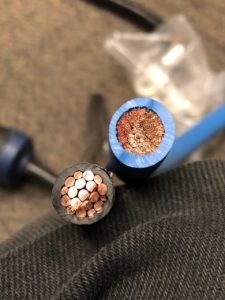
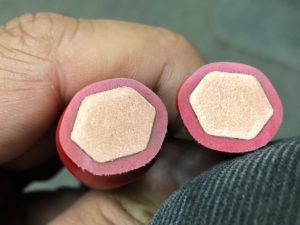
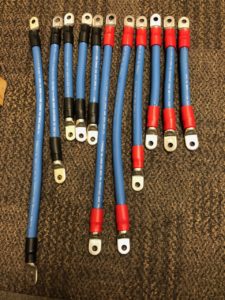
For the KYD install, we used 2/0 cable which is capable of handling 330amps. The cables are called Arctic Ultraflex and will stay extremely flexible from -50C to 105C. What makes these cables better and more flexible than your standard 2/0 cable that you can get at most hardware stores? Arctic Ultraflex carries a class K stranding rating. What is a class K rating? It is a classification of the number of strands contained in a specific sized cable. Take our 2/0 cable which contains 1330 individual strands of copper.
If you were to go to a hardware store and buy a 2/0 cable, it is usually a class B rating. A class B 2/0 cable contains 19 strands. Having a lot more and smaller strands make the cables more flexible for routing and pulling the cables when you do your install.
The ring terminals were crimped on to each end of the cable is thicker than most terminal ends and it is fully tinned and sealed to help prevent corrosion. We also utilize a 6 sided or Hexagon shaped crimp to get the most uniform crimp.
Once the cables are crimped we use an extreme duty heat shrink to seal between the cable and the terminal. Why would we use this thick a heat shrink on our cables? With the thicker heat shrink, it minimizes the chances of the heat shrink loosening up over time or possibly getting worn through if something happens to rub against it. It also contains an adhesive on the inside of the heat shrink which melts during the heating process to completely seal the connection not allowing moisture, water, or acid to get into the cables and allow corrosion to start.
Why are my cables blue instead of red or black like everyone else’s cables? By going with a neutral color for the cable, this allows us to customize the cables for your individual needs. If you are hooking up your batteries in parallel, we can make your cable with black on each end for the negative connection and red on each end for the positive connection. If you are setting up your batteries in series, which would be connecting positive from one battery to the negative of the other battery, we can make the cable with one end being red for the positive and the other end being black for the negative so there is no confusion when you are connecting or disconnecting your batteries.
How does everything fit together?
Jared’s video breaks down each product listed above and shares a diagram of how everything is connected. Jared’d channel, All About RVs shares all sorts of helpful RV tips and Do-It-Yourself projects. Subscribe here.
KYD Partners & Affiliates
Not so small print: Zamp Solar & Battle Born Batteries are KYD Partners. We are not getting paid, but rather they provided the product so we can share the installation process plus a review as we use the product. We do have an affiliate relationship with Battle Born, but be assured that if for any reason, our batteries do not continue to meet our expectations, we’ll share the results and not recommend the product. The reason we enjoy working with partners is so we can explore products and solutions we might not otherwise be able to use and these companies take care of the KYD community.
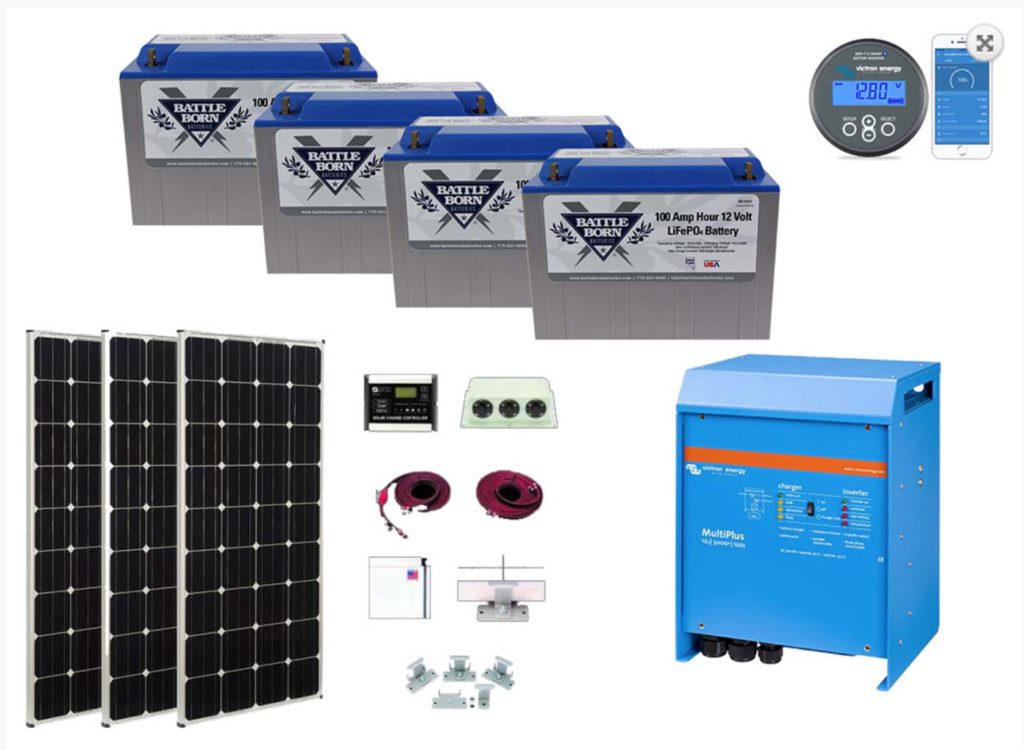
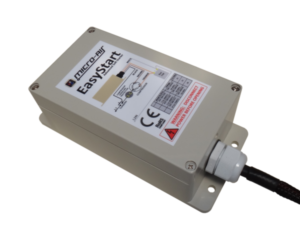

I see you spent $7296,00 on your Battle Born Batteries Keep Your Daydream 400ah Lithium 480 watt Solar Bundle . I take it that it does not include man hours to install it. So my question is, how long will it take to pay for it’s self? That is because $7296.00 is a large sum of money to dish out. I just wondering your solar panel payback or “break-even point” will be. Would that be 3 years, 6 years or is it longer?
We mentioned the RIO in the blog above, but I think it would be different for everyone. How much time on the road. How much is the average RV park. Out much output is really needed. For us, I think it’s 48 days per year over 3 years.
J Johnson, it seems if the system costs $8k with tax and the average RV park cost is $50 per night, it would take 160 boondocking days to break even on cost – so however long it might take you to to hit 5 or 6 months. Plus freedom, peace of mind, and not hearing the dang generator humming along are all worth something too!
Happy travels
You’re exactly right. Not cheap, but bing fulltime its easy to justify. What we get in reduced fatigue and options is very nice.
Well, I think you will find that you have put about 1/3 the amount of solar panels and 1/4 the amount of amp hours or battery that you will need. If you truly want to be more self sufficient more for off-grid/boon docking. I understand that you plan on moving alot and getting batteries to full charge pretty quickly from the truck alternator while towing. It is a good start, using the victron equipment and some batteries……. I will watch and see what ends up happening as you travel in different weather (charging) conditions.
So far so good. The batteries seem to be at 100% in the am when we dry camp, but we’ll need more time. The good news is, it’s simple at this point to add another panel or two or batteries or two. AK won’t be easy due to the angle of the sun, but we’ll get lots of driving time…. once I can figure out why my truck isn’t sending a relay back. I’ve checked both fuses. No luck.
Great video. Thank you! I was wondering how often you’d have to change out the Lithium batteries? Boondocking is more our style when we had our Popup but now that we are in the process of looking for our TT, we’re wanting to be able to have the best of both worlds. It will be my wife and I only most of the time so our usage will be less but when we eventually want to head out west and be able to run things off of the batteries when we get into the boonies. Trying to decide if going to the setup you described is more economical vs a generator. Would love to not have the sound of the generator but we’ll see. Thanks for all of the info.
Todd, From all the research I have done the battle born lithium batteries have a life span of about 3000 cycles or 10 years.
Thank you, Thank you. Thank you. I get it now!
Nice.
Great video Marc. Loved both of them.
1. Do you have a battery ‘Disconnect’ switch? In case of fire or you want to work on the electrical system.
Fair winds and following seas.
Thanx, your videos are a great inspiration.
Thom
(Pulling the trigger with ‘A Wandering Turtle’ in 370 days.)
Hi Thom! Yes, disconnect added.
Thanks for this breakdown. Very helpful. I struggle with electrical equations, etc. am I correct that 480 watts of solar is charging the batteries at 40 amps per hour? And a 3,000 watt inverter can run for how long on 400 amps of battery? How do those calculations work? Thanks again.
Mark, can you provide details of the temperature activated cooling fan that was added by one of your subscribers to your rig. My 4 LiFePO4 (BB) batts and AIMS 3K I/C is under our bed and we plan to add some circulation with a similar unit.
PS I liked your install video very much. It is comforting to see how well we aligned our thinking for the install. May see you someday on the road!
Yes, I’ll let Mark reply. Mark?
RV GEEKS had a video from 2014 about tilting the solar panels when boondocking to capture the most sun energy. Wish you all well on your trip. Love your channel.
That would be great for AK. I should have asked Zamp about that!
I would highly suggest finding a way to modify or (gasp) replace your mounting brackets to allow for approximately a 30 degree tilt for your panels. The loss in solar collection in Alaska and winter months in the lower 48 states will be significant without it.
I agree. Too late now. Might be a mod I look into later. I should have thought of that sooner though. The channel keeps us busy right up until the day of the project.
So I k ow tou made a video but what all can you run with new set up and for how long?
Our needs are simple. We charge 2-3 laptops, phones and camera batteries pretty much 24/7. We run the coffee maker for an hour or two in the morning. Trish runs the hair dryer for 5-7 minutes… and so far we’re back at 100% by the am each morning. More to come as we use it more, especially on cloudy days.
How do you think this would work with Dogs? We tend to take our pups with us and alot of times when we leave they have to stay in the rig. Being in Texas we’ve chained ourselves to RV parks so we could leave the AC on. Curious if there was a good solar way to handle this.
I think it would work for a short while. Did you see our RVing with Dogs video? I would pair this with a monitor system so you can check the temp of your rig via cell phone.
We are rv newbies (full time) and we dont have the type of money to do a large solar setup. My question is, is it worth buying a portable (100-120) solar panel? Do they give any power worth while?
Derek, you can build solar systems for far less then this setup. The best thing to do is to determine what you plan to run, and for how long. Then build a system around it. I have a setup that allows me to run all my lights, charge laptops, phones, run 2 max air fans 24/7 and it barely touches my system. Total investment is around $1200, and is expandable to grow as I have more money to invest in it.
William, I’d love to see your system.
No mention of why you did not choose an MPPT controller. Were you sticking to the ZAMP brand and they do not offer or are the efficiencies of the MPPT over PWM controller not worth the extra cost?
Thanks,
Peter
I just didn’t know about it. I might upgrade. We’ll see. So far it seems we have more power than we use. We’ll see what happens as we travel more.
just to jump in here.. PWM controller are less costly and with only 460 watts and 12v panels make more sense than a MPPT..
I will be putting a total of 460 watts of 12volt panels on my airstream in the next year. For the time being and as a back up (shady area) I was able to secure a 335 watt 24 volt (37.9 Vmp) panel I mount on my camper top of the pickup. (I can move some 25 ft from trailer).. I do see a lot of advantages with the higher voltage panel with MPPT controller vs the PWM in this case..
Until they get more panels and/or wire them in series (higher voltage) this system will work fine. MPPT shines with higher voltage input.
good luck with alaska trip..
Good to know. I don’t really geek out on the details here (as I’m sure you know). I just like to run my coffee maker and keep my laptop charged. The PWM vs. MPPT was a big debate in the comments… but we moved on to Bozeman, Jasper and AK and didn’t look back! 🙂
With this setup, you’ve pluged half of the power panel to the inverter. Is the power from the parks (30 or 50 amps) will take over or it is always running under the batteries?
Also I’m curious to see when the daylight shortens
Sorry if I make mistakes in orthographe or phrasing, english is not my first language ????
Oh BTW I love your YouTube channel
Yes, when connected to shore power, it takes over. When not connected, the battery operates the one pole with the appliances we selected.
Not a solar question but which RV park were you staying while having the solar panel system installed?
Point of Rocks in Prescott, AZ.
Nice video and nice installation. That said, I think you might be under powered solar and controller wise. The lithium batteries are nice, and I’m looking at that as an upgrade. In the meantime, we have 4 golf cart batteries so 400+ A-Hr, with about 200 A-Hr usable. What I found in the evening last winter in AZ we would get down to about that magic 50% level in the batteries overnight and with a 45 Amp charger it wouldn’t always get charged back up all the way the next day. The reason was that the 45 Amps is really offset by any power you use during the day so it was effectively much less available to replace the energy in the batteries. At times, I ran the generator to supplement the solar to keep them topped off. So it will interesting to see if you can keep the net balance positive as you travel, especially as far north as Alaska. But you will love that trip anyway. We did it last summer and had a blast.
You mentioned powering your fridge via your battery bank. How long can you supply it power before needing sun to recharge the batteries?
The outdoor fridge uses about 5amps or so. Maybe 7. So in total, we’re using 12 amps at all times. When the sun goes down, we’ll wake-up at 85 to 90% charge and be at a 100% pretty quick. On rainy days, I’ll unplug the outside fridge so we’re only drawing 4-5 amps.
Thanks for the great tip on the EasyStart Soft Starter. We aren’t ready to do a solar upgrade yet, but loved learning about this handy device so we can use our air conditioner with a generator. I sent my husband the info and he said “get it”.
Thanks even more for the discount code!
My husband and I are retired military. We can boondock in Key West on the Navy base in winter as long as we want for only $15 a night. They have great shower and dump facilities, so it’s great until there is a heat wave. This little device will allow us to cool down our camper at before calling it a night – perfect!
great video… i’m wondering about a couple things: first, i don’t remember you saying anything about the dc circuit of your trailer…. did you tie the new batteries to that? if so, you must have removed the converter, since your new multi=-function inverter does battery charging. perhaps there is something in the dc wiring you guys missed that causes your truck’s alternator not to charge your batteries.
second, we have a 3000 watt pure sine inverter as well (no where near the batteries you have — maybe someday) and we have tried running the hair dryer. it always cuts off when on “high”, but works on low. it isn’t the batteries, it is the inverter that seems to want to shut things down. do you run the hair dryer on low or do you have some special type of hair dryer? seems 3000 watts would be 3000 watts and would be plenty to run a 1500 watt hair dryer for a couple of mins, but i would guess there are better and worse inverters out there.
I wish I had more info for you. I’ve heard from others that their 12v or even 6v batteries have been damaged over time (from running to zero) and can’t handle the high loads anymore. I’m wondering if that’s the issue, but I don’t for sure.
If you look at the wiring diagram you will see a 12v wire from the batteries to the panel. Their converter is unplugged.
Fantastic explanation video for novices! Thank you, Marc!!
Marc, sorry if this has been talked about but I was wondering about the added weight of this system. What was the total weight and were you guys close and have any issues with bumping up against the upper limit for your rig. If so how did you handle it?
All this stuff did add weight, but we removed much more. Much more. We weighed with full water (max!) and we were still under our GVWR and GAWR.
I was really hoping to find the kind of wire you used to go from the inverter to the breaker box and from shore power back to the inverter. Can you please post this.. This was one of the parts of the install that I wanted to see the most and it was just barley touched on.
Thanks for the posts.
Larry
We just matched the wire with the 8/3 that was in the rig. Got it at Home Depot.
I firmly agree with starting small and getting bigger. What I have not been able to do is find a starter kit that actually helps the RV owner do this in a practical way. In my fantasy world there would be a kit that starts out with 200 watts of panels 200 amp hours of battery 3k watt inverter, and a charge controller that can manage charging multiple battery types at the same time. That way when you have money for more batteries and or panels you just add them. Maybe I just don’t know how to look for this but I haven’t seen it. If there is a charge controller that can manage both AGM and Lithium batteries at the same time that is where I would spend my money like today.
Charlie,
My name is Patrick from Suntech solar in Canada. I believe I can help you set your RV up for what you need. Please visit our webpage for information and feel
Free to contact us with further questions!
Thanks.
Great video and blog. Thank you so much for putting this together. We purchased a 28foot C-class mainly to see if my wife would enjoy RVing since she HATES camping and made that very clear. 1 year in and she is asking to upgrade to a larger RV. This was very helpful especially the pricing etc laid out. While I do want to go solar I might wait to do something like this on the next RV and come up with a temporary solution till then.
We love your videos.
Thank you
Marty
Question, how does this solar set up effect WEIGHT ?? We are always counting,
Susan, the panels add about 24 pounds each, the inverter is about the same so figure 100 pounds with the panels and charge controller. The batteries are where you start to save weight, the battleborn batteries weigh just under 30 pounds each and give you 80 to 100 amp hours. The typical RV comes with a single battery that weighs between 45 to 50 pounds and gives you between 70 and 80 usable amp hours, a little more weight and capacity if you have 6v (golf cart) batteries. Rough numbers if you had two golf cart batteries this system probably added 130 pounds (180 if you had a single 12v battery) but they went from having roughly 110 usable amp hours to nearly 400 amp hours and the ability to recharge roughly 160 amp hours daily in good sun.
Marc,
What is the maximum amp output from the solar panels you have seen so far during peak sun?
I’m curious why you decided to let the inverter power only one side of your panel. I set mine up with a transfer switch, so the inverter powers my whole panel (both sides). This way I can use anything I need without searching for an outlet or needing to fire up the generator. Of course this requires load management, but when on inverter power one needs to manage their loads anyway.
I’m glad you went solar, you are just now beginning to experience the freedoms it provides, as time goes on, you will realize that the list of benefits and conveniences is endless. 🙂 I have physical disabilities, and now, with the exception of needing a/c all day, I don’t even bother plugging in, even if I have shore power available. That alone is a big blessing, not to have to drag out the big 50amp cord. I have enough solar and battery capacity to even charge my mobility scooter through the night. I could not be more happier.
Safe and happy travels on your amazing trip to Alaska!
We’ve seen about 26amps. That’s as much as I’ve seen so far.
How do the aimed-up mounted solar panels work in the always angled (sideways) sun of Fairbanks Alaska? Just curious.
We don’t with these, but that would be a nice option!
I assume that you put holes in your roof to mount your panels because the outside layer of the roof was not substantial enough to hold the panel with tape. Most installs I have seen use VHB tape, the downside is that once you mount it, it’s not coming off, it is permanent. Putting holes in the roof not matter how well sealed put you at risk of water damage. Aside from that as usual great video!
Can you give more detail on which breakers you moved? Ie: what they were actually labeled in the box? I have a couple that I’m not sure what they are for.
Left side— conv, a/c, gfi, gen
Middle—-Main main
Right side—- w/h, micro, f/p, w/d, b/ac
Which should I switch?
Thank you
Sharon
Not sure of what some of those do but the one that says converter should always be off in a system like this.
Great install and videos, we are finally upgrading to include an inverter in our system and also chose the Victron MultiPlus. The only part we have struggled with is the lithium batteries, we see all the pros but the one con for our part time usage is the cost. We just can’t convince ourselves to get rid of our golf cart batteries, perhaps when they start to fail we will re-think this. Our system is similar but with 4 golf cart batteries so we will see how they do when I get the inverter installed. Safe and happy travels, we look forward to seeing your adventures!
Love the video, and all the others I’ve seen. Tomorrow starts our own freedom 8/8/18 we are taking of too. Starting in Texas we will be heading slowly to Niagara falls, and hope to be in DC for the Nov 12 parade. We are starting our trip in a 99 dodge 3500 diesel, with a 88 Lance truck camper on top. Next year will probably be in a 5th wheel or trailer of some sort.
I hope to up grade to your system. right now I have 2 arms and 400ws with MPPT controller and 2000w pure sin wave inverter. All working fine so far knock in wood. As I went as cheap as I could and installed my self. Hope to see you on the road and have a beer.
I love this write up but am disappointed in that I have been waiting for someone with a newer Grand Design trailer to install solar so I could learn how to do mine. The problem is that both Mark and Jared are too busy to answer my questions.
Two simple questions I had was how did they remove and replace the panel where they pulled the wire up and installed the charge controller and the other question I had was how long were the screws on the roof that hold the solar panels down.
I sure wish I could get these questions answered.
Thanks
I have a 1990 Layton skyline 5th wheel trailer and I purchased this power max converter. I would like to know if it would work with Lithium Ion batteries?
Power Max PM4 100A 110V AC to 12V DC 100 Amp Power Converter with Built-In 4 Stage Smart Battery Charger
Alvin
Mark & Trish,
Great information on solar install. Thanks for sharing. I just got a new GD Reflection and plan on doing a solar install. The information you shared is invaluable. I know you’re inundated with comments and can’t reply to everyone. But I’ll try.
1. Is 400 amp hours enough (would you go more or less)?
2. Knowing what you know now, what improvements would you do to the solar install or the system?
Thanks for sharing your adventure and experiences. It’s been great watching you guys.
Where do you store your portable panels safely that you use when you park in the shade? I have been thinking of starting with some of those and working my way up but and worried about finding a secure place in my rig where i wont bust them. Thanks!
Can you link two 12v batteries together, instead of having to go out and buy two brand new 6v’s? I’m looking for an affordable option for solar for my new fifthwheel.
awesome blog about solar panels.. thanks for sharing this with all..
Marc,
This may sound crazy but the problem I’m having is sourcing the felt material used by GD in the storage bays? I’m installing a 1280W Solar system provided by Northern Arizona Wind and Sun. I can reach out to them next week but wondered if you could tell me where you found the matching material? I’ve searched fabric shops and the big stores locally and no dice. Thanks.
This is a great guide, thanks for putting it all together!
Hey guys! So I love the system with the battleborn batteries and would love to do a similar set up for our motorhome. My question is what would the cost be for having the same system professionally installed on a 32 to 34 foot motorhome?
can you explain to me the advantages or disadvantages of using 6volt vs. 12 volt batteries on a solar configuration???
Marc is there a possible problem with the truck’s alternator being damaged by the Li batteries?
Question: If I was going to buy a 2021 RV, would be a good idea to get the solar package? And what if the solar package doesn’t include a battery charge controller for lithium. then what are my options.
Another great bit of information that is super helpful! Just wanted to say thanks!
I’m wondering how can I achieve my needs of AC power from mppt solar charge. I understand that if I set up an mppt solar system, it will charge the 12v battery, providing power for all 12v wiring. However, if I’m not connected to shore power, how do I power my AC outlets using solar?